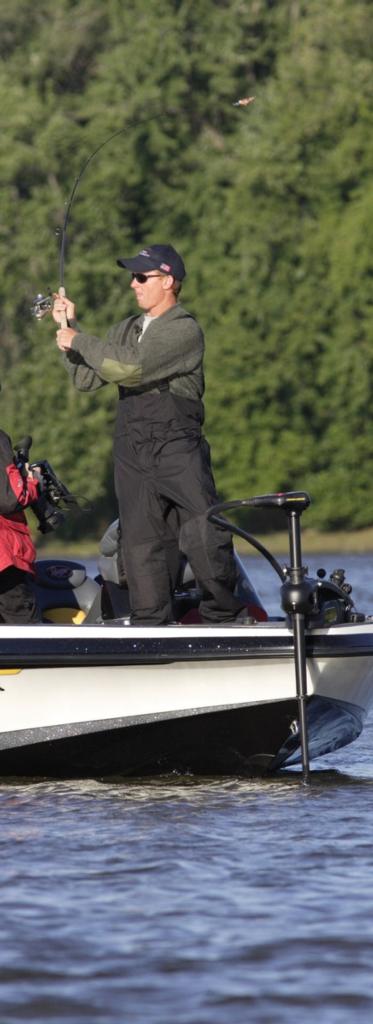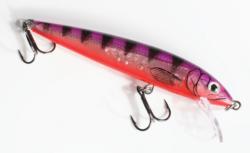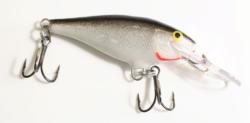Big spawning walleyes of the Great Plains
When winter loosens its formidable grip on the Great Plains, walleye experts know their quarry will be embracing the spawn – here’s how to fish it

North and South Dakota are legendary – infamously so – for the brutal Great Plains winters they serve up. But once those winters finally recede, and spring begins to cloak the flatlands, walleyes of the plains come to life. As Wal-Mart FLW Walleye Tour pro Troy Morris said, “Walleyes are biting all the time, somewhere. It’s just a matter of being in the right place.”
Morris was raised in Bismarck, N.D., and has been a walleye fanatic for most of his life. He turned pro back in 2000, works as a rep for Ranger Boats, and now fishes the FLW Walleye Tour. He’s done well in tournaments, including a fifth-place finish at Green Bay and seven top-20 finishes.
Renowned walleye water for Morris is all around him – places like Devils Lake and the Missouri River system, including the Missouri’s oversized impoundments of Sakakawea, Oahe, Sharpe, Francis Case and Lewis and Clark.
“I’ve done a lot of fishing on the river system down to Pierce, S.D., and Lake Sakakawea,” Morris said. “The fish are in prespawn in late February and March. But come April, up into May, they’re all in spawn mode.”
Missouri River system spawners
On the river itself, fishing in April for spawning walleyes means bar hopping – that is, looking for fish in slack-water eddies, which are almost always found behind the river’s extensive labyrinth of sandbars. In March, most of these locations are filling with bucks, but by mid-April, the bigger hens have joined them.
The key component to successful sandbar fishing is working skinny water – as shallow as 4 to 7 feet deep. “You find those places behind the sandbars, and the thing I like to do then is to pitch a jig,” Morris said.
The pro pitches 1/4-ounce roundhead jigs or uses 3/8-ounce jigs if he’s fishing a slightly deeper spot vertically. “You can use any color you want, so long as it’s chartreuse,” Morris quipped. The Missouri is stained, so bright colors are paramount. He tips his jigs with 3-inch fathead minnows hooked through the jaw and prefers No. 2 jig hooks.
The river’s temperature is typically still cold by lake standards in April, with 48 degrees being ideal to trigger spawning. “The water stays cold a long time,” Morris says, “because of the colder water coming out from the bottoms of the dams.” Still, anglers should expect these fish to be super active. Once the females are up on the shallow flats to spawn, the fish are aggressive. Some of the river’s big spawning hens can hit 20 to 26 inches in length, achieving up to 8 pounds as their eggs mature.
Impoundment walleye tactics
The Missouri River flows out of Ft. Peck Lake in Montana into Sakakawea and then runs as a river until it reaches Lake Oahe. Below that, at Pierre, S.D., it’s a river again, before finally flowing into Sharpe and then on to Francis Case.
Morris knows these impoundments well – Sakakawea is 60 miles north of where he lives and Oahe is 60 miles south. “Both have the same structure, both are very similar bodies of water,” Morris said. “But while you’re looking for sandbars in the river, you’re looking for the rocky points in the impoundments in April.”
 Walleyes will be spawning in the impoundments in April, too, though the reservoirs are so big that fish in one part of them can be in prespawn, while fish in another part can be in postspawn and, overall, spawning runs deep into May and even early June. There’s virtually no current. In spawning mode, the walleyes are typically in 6 to 10 feet of water, hugging those rocky outcroppings.
Walleyes will be spawning in the impoundments in April, too, though the reservoirs are so big that fish in one part of them can be in prespawn, while fish in another part can be in postspawn and, overall, spawning runs deep into May and even early June. There’s virtually no current. In spawning mode, the walleyes are typically in 6 to 10 feet of water, hugging those rocky outcroppings.
A top method is a kind of no-nonsense, dedicated trolling – flatlining monofilament, without planer boards or leadcore, pulling a No. 5 Shad Rap. If the water is clear, Morris uses natural colors and metallics. If it’s stained, he goes to the old standbys of firetiger and chartreuse. His biggest fish have come this way, including several 8-pounders and his personal best, a 9 1/2-pounder.
Devilish walleyes
In addition to the river system and its attendant monstrous reservoirs, the Great Plains is dotted with potholes and small lakes, the names of which for some are known only to locals. But one natural lake that’s known by almost every walleye angler in the country – at least by reputation – is Devils Lake in North Dakota.
It’s a natural lake of intense beauty and structure. Rising water over the past decade has decidedly grown the lake, expanding into oases of flooded timber and new emerging weeds. It offers the walleye angler an opportunity, as some anglers will point out, to use bass and crappie fishing tactics to catch walleyes.
“In April, the fish are shallow – real shallow,” Morris said, “like in 2 to 4 feet of water.” A variety of approaches work, including casting crankbaits like Shad Raps and Husky Jerks, pitching jigs and slip-bobber fishing in the flooded timber.
It’s slip-bobber fishing that provides a corollary to crappie fishing. “We use small, 1/8-ounce roundheads tipped with a minnow or leech, thrown into the timber,” Morris said. “The big females are up in that stuff spawning. The guys I see making mistakes and not catching fish are the guys who aren’t fishing shallow enough. These fish have adapted to shallow water.”
The `most fun’ place to fish
Nick Johnson of Elmwood, Wis., is having the time of his life. He turned walleye pro after his company exported his job to Mexico and laid him off. Since then, he’s fast developing a reputation as a leading tournament champion. He won the 2004 FLW Walleye Tour Championship and the 2005 FLW Walleye Tour Angler of the Year title. He won at Bull Shoals in Arkansas last spring, and has banked a cool $430,000 in winnings.
 For Johnson, Devils Lake is one of the most fun places to fish. “If I had to pick a spot to fish and have fun, just have a good time, Devils Lake is it,” he said. “That’s because of the sheer amount of fish and the diversity of how you can catch them – crankbaits, slip bobbers and big-water trolling. Everything works. There are so many fish in that system; it’s just a blast. The people are super, and so friendly, too. It’s my favorite place.”
For Johnson, Devils Lake is one of the most fun places to fish. “If I had to pick a spot to fish and have fun, just have a good time, Devils Lake is it,” he said. “That’s because of the sheer amount of fish and the diversity of how you can catch them – crankbaits, slip bobbers and big-water trolling. Everything works. There are so many fish in that system; it’s just a blast. The people are super, and so friendly, too. It’s my favorite place.”
April can be a prime time to fish Devil’s Lake, but Johnson is more fond of May and June. “June especially is one of the peak times, from the first part of June to the end of it,” he said. “The fish are up shallow still, weeds are coming up good, the fish are relating to emerging vegetation, and they’re in the wood. There’s just so much structure to fish.”
Devils Lake gets tougher as summer comes on. Those legendary winters turn 180 degrees into blistering summers racked with relentless winds. “The walleyes tend to leave the wood then,” Johnson said. “Then it’s a morning and evening thing.” But before then, the wind determines where Johnson starts fishing.
“I realized right away when I started fishing Devils Lake that it’s a wind-driven thing. Any shoreline where the wind is blowing in, especially if it’s been doing that for two, three or even better, four days, boy, the fishing can get spectacular. You’re looking for windblown shorelines with weeds and wood. But it can get expensive throwing crankbaits into that kind of stuff.”
It’s not only expensive because of the crankbait-grabbing timber, but also because of the overabundance of northern pike. “The northerns are so thick in there; you’ll catch 50 to 60 of them for every 15 to 20 walleyes,” Johnson said. He tends to use 17- to 20-pound Fireline, with a light, 20-pound-test, hand-tied steel leader. “The walleyes aren’t picky and don’t care about the leader,” he said, “and the steel leader keeps you fishing despite all those northerns.”
An interesting side note, Devils Lake is also full of freshwater shrimp – so much so that the ravenous pike are orange-meated from feasting on them. “It’s unbelievable how many shrimp there are,” Johnson said. “You bump the trees with your trolling motor, and they scatter. The water’s covered with them.”
For tossing cranks, Johnson likes the shallow variety. “I like the really shallow-running baits, like a gold and blue Husky Jerk, or a No. 5 or No. 7 Shad Rap. But it’s got to be shallow. And I prefer a heavier crankbait because they have more weight, and I can cast more, especially in the wind.” Wind is such a factor that he repeats the local saying about it: “If the wind in the Dakotas ever stopped blowing, everyone would fall over.”
Even on nasty wind days, however, Devils Lake offers reprieves, with countless nooks and crannies where boaters can seek refuge. The important thing is to continue to work the windblown shallows whenever possible.
In April, Johnson and Morris agree the worst thing anglers can do is to fish too deep. “Those walleyes move up, and I mean they really move up, even into places where you can’t get a boat,” Johnson said.
Slip-bobber fishing
Once the dominion of crappie anglers and bluegill worshippers, slip-bobber fishing is now a major strategy for tournament walleye anglers. Nick Johnson, last year’s FLW Walleye Tour Angler of the Year, tries to keep his approach as simple as bobber fishing itself.
“It’s a real simple deal,” he said. “There’s nothing hard about it. The main thing is, use big enough hooks. I like a No. 2. Set your bobber a foot or two off the bottom.”
While a lot of anglers anchor and let the fish come to them, Johnson is more aggressive. “I keep moving,” he said. “I’ll sit there for 15 to 20 minutes. Then I’ll move. Maybe not far. I may go 50 yards down the break line and tie up again. But I keep moving.”
Johnson studies his electronics, especially in shallow-water situations. “If it’s 10 to 12 feet, and then all of a sudden there’s a jump of 2 or 3 feet, maybe up to 6 or 8 feet of water, I’ll anchor up and fish the bobbers,” he said.
Johnson prefers a heavily weighted bobber. “I want it to weigh enough to barely float,” he said. “If your bobber is too light, then when you have a lot of wind it’s riding the wave up, and that’s jumping your bait too much. If the fish are lethargic, they don’t like that jumping action. So I want enough weight for the wave to go over the bobber, instead of riding it up.”
The pro uses bobber-stoppers on occasion, but more often, he just ties a rubber band on with a half-hitch. To his main line he slips on a slip sinker, and then ties on a barrel swivel and then a leader. If he gets stuck in the timber, or on the bottom, he pops off the leader and just ties on a new one.